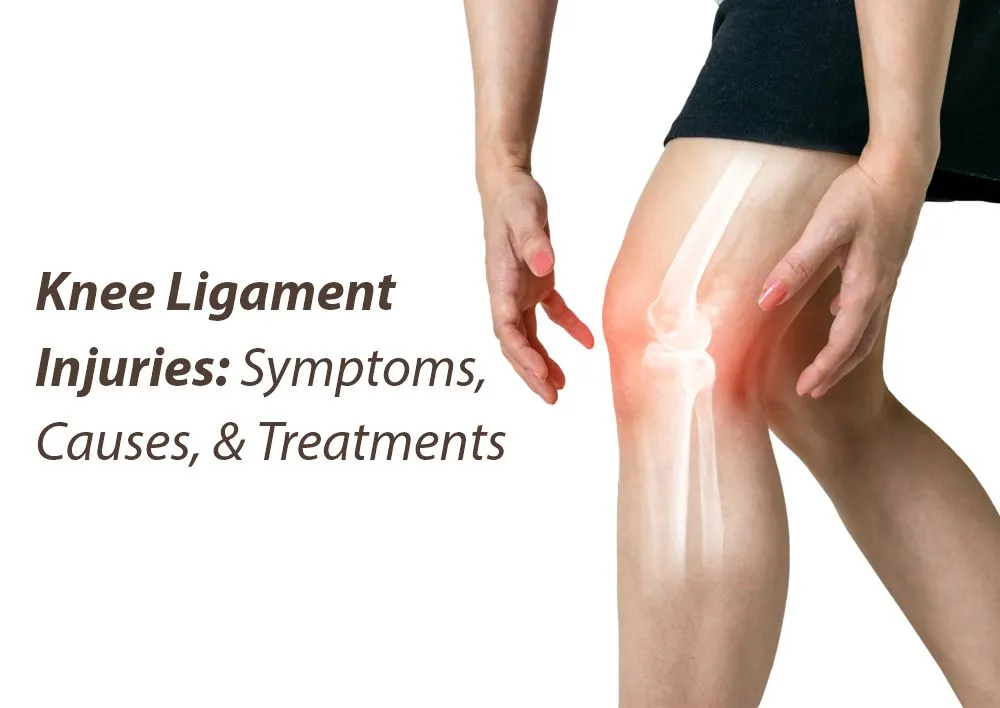Knee Ligament Injuries: Symptoms, Causes, & Treatments
Knee ligament injuries are very common. They can affect any knee ligament, mainly the anterior cruciate ligament (ACL), posterior cruciate ligament (PCL), medial collateral ligament (MCL), or lateral collateral ligament (LCL). Injuries to these ligaments can range from mild sprains to complete ligament tears of the knee. The severity of the injury often decides the right course of treatment, which may include rest, physiotherapy, or surgical intervention.
Miracles Apollo Cradle/Spectra stands as the best hospital for ligament injury treatment in Gurgaon. We are dedicated to providing unparalleled care. Our state-of-the-art facility has a dedicated team of orthopedic doctors in Gurgaon to provide personalized treatment plans for knee ligament injuries. From accurate diagnostics to cutting-edge surgical interventions and comprehensive rehabilitation, we prioritize individualized care for optimal recovery.
If you or a loved one is seeking top-notch ligament injury treatment, trust Miracles Apollo Cradle/Spectra for guidance on the path to recovery. Contact us today to schedule a consultation with an orthopedist in Gurgaon and take the first step toward mobility and well-being.
We will explore Knee Ligament Injuries, Their types, symptoms, causes, potential treatments, and effective preventive measures.
What is Knee Ligament Injury?
Knee ligament injury refers to damage or tears in the ligaments of the knee joint. Ligaments are tough, flexible bands of tissue that connect one bone to another. Injuries or tears to the knee ligament often result from sports activities, accidents, or sudden movements that stress the knee.
Types of Knee Joint Ligaments
Our knee joint is supported and stabilized by four main ligaments. Each ligament plays a crucial role in maintaining the structural integrity of the knee.
These ligaments are:
-
Anterior Cruciate Ligament (ACL): The ACL is located in the center of the knee. It helps prevent the tibia from moving too far forward. This ligament contributes to rotational stability.
-
Posterior Cruciate Ligament (PCL): This ligament is situated at the back of the knee joint. The PCL prevents the tibia (shinbone) from moving too far backward. Compared to ACL, this ligament is generally stronger. It provides stability and prevents the femur from sliding off the front of the tibia.
-
Medial Collateral Ligament (MCL): It is located on the inner side of the knee and helps prevent the knee from bending too far inward. It also contributes to the stability of the inner part of the joint.
-
Lateral Collateral Ligament (LCL): This ligament is positioned on the outer side of the knee. The LCL helps prevent excessive side-to-side movement of the knee. It provides stability to the outer part of the joint.
Types of Knee Ligament Injury
The knee is a complex joint. It relies on four main ligaments to maintain stability and allow for proper movement. These ligaments can be injured in various ways, leading to pain, discomfort, and difficulty moving the knee.
Here are the four main types of knee ligament injuries:
-
Anterior Cruciate Ligament (ACL) Injuries:
-
ACL Tear is the most common. It often occurs during sports that involve sudden stops, changes in direction, direct contact with the knee, or jumping.
-
The symptoms of ACL injury may include a popping sound at the time of injury, swelling, instability, and difficulty bearing weight.
-
-
Posterior Cruciate Ligament (PCL) Injuries:
-
PCL injuries are less common than ACL. They occur as the result of a car accident or a fall on a bent knee.
-
The symptoms of PCL injury may include swelling, pain, and instability.
-
-
Medial Collateral Ligament (MCL) injuries:
-
MCL injuries are common in athletes, especially football and soccer players. They are caused by a blow to the outer side of the knee.
-
MCL injuries range from mild sprains to severe tears. They are characterized by swelling, pain, and instability on the inner side of the knee.
-
-
Lateral Collateral Ligament (LCL) Injuries:
-
LCL injuries are less common and typically result from a blow to the inner side of the knee.
-
The symptoms of LCL injuries include pain, swelling, and instability on the outer side of the knee.
-
-
Multi-Ligament Knee Injuries:
-
In some cases, multiple ligaments can be injured at the same time, leading to complex knee injuries.
-
Grades of Knee Ligament Injuries
Knee ligament injuries are classified into three grades based on their severity. The grading helps the orthopedic doctors determine the extent of the injury and plan an appropriate course of treatment.
Grade 1 (Mild):
-
Ligament fibers are stretched but not torn.
-
Minimal to no joint instability.
-
Mild pain, tenderness, and swelling around the injured ligament.
-
Mild injuries can be managed with non-surgical treatments such as rest, ice, compression, and physiotherapy.
Grade 2 (Moderate):
-
The ligaments are partially torn.
-
The joint instability is moderate.
-
Compared to grade 1, you may experience increased pain, swelling, and tenderness.
-
Depending on the ligament involved, Grade 2 injuries may be managed with non-surgical treatment but in some cases, they may require more advanced interventions.
Grade 3 (Severe):
-
Complete rupture or tearing of the ligament.
-
The joint instability is high.
-
Substantial pain and swelling.
-
Injuries of grade 3 generally require strong treatments, which may include surgery to reconstruct the torn ligament.
What are the Symptoms of Knee Ligament Injuries?
Recognizing the symptoms of a torn knee ligament at an early stage can help you seek timely treatment. Some common symptoms of knee ligament injuries include:
-
Sharp pain to Dull ache
-
Swelling around the injured area
-
Popping or snapping sound
-
Instability
-
Difficulty in Knee Bending
-
Difficulty Straightening the Knee
-
Tenderness
-
Loss of range of motion
-
Walking difficulty
What are the Causes of Knee Ligament Injury?
Several situations can cause injury to knee ligaments. Some potential causes include:
-
Sudden changes in direction
-
A blow to the knee
-
Falling onto a bent knee
-
Repetitive strain
-
Muscle imbalances
-
Previous injury
-
Naturally loose ligaments
-
Misalignment in the knee joint
-
Poor foot stability
-
Improper playing surface
What are the Risk Factors of Knee Ligament Injury?
Several factors can increase the chance of knee ligament injury including:
Internal factors:
-
Anatomy: People with naturally loose ligaments or misalignment in the knee joint are more inclined to ligament injuries such as sprains and tears.
-
Muscle imbalances: Weak or tight muscles surrounding the knee joint can change biomechanics and force distribution. This can put your ligaments under increased stress.
-
Previous injury: A weakened ligament from a prior injury is more susceptible to re-injury, even with less force.
-
Gender: Females are statistically more prone to ACL tears due to hormonal and anatomical differences.
External factors:
-
Activity: High-impact sports like football, basketball, and skiing significantly increase the risk of ligament injuries. Because they involve sudden changes in direction and jumping
-
Overuse: Overuse or repetitive strain without adequate rest can cause micro-tears in the ligaments. It can lead to inflammation and pain.
-
Improper Shoes: Worn-out shoes with poor support can contribute to poor foot stability and increase the risk of knee ligament injuries.
-
Technique: Incorrect form and movement patterns during exercise or playing can put unnecessary stress on the knee ligaments. It makes the ligaments more vulnerable to injury.
Additional Factors
-
Fatigue: When you're tired, your muscle control decreases. This makes you more susceptible to accidents and injuries.
-
Inadequate warm-up and cool-down: Skipping the crucial steps including warm-up and cool-down before and after any strenuous activity can leave your muscles and ligaments unprepared and increase the risk of injury.
How Knee Ligament Injury Can be Diagnosed?
Diagnosing a knee ligament injury requires a combination of medical history, physical examination, and imaging tests.
Here's the detail of the steps involved:
-
Medical History: Your orthopedic doctor will ask about the details of the injury, including: How it happened, the severity and location of pain, previous medical history, the history of previous knee injuries, current activity level and participation in sports, and any other relevant medical conditions or medications.
-
Physical Examination: Your doctor will assess your knee movement, range of motion, and stability. They perform specific tests for each ligament. The tests might involve applying manual pressure or stress to the joint in different directions.
-
Imaging Tests: The physical examination can provide valuable information. To confirm the diagnosis and the extent of the injury, your orthopedic surgeon may order imaging tests such as:
-
X-rays: The X-rays are primarily used to rule out fractures. But they don't show soft tissue like ligaments.
-
MRI (Magnetic Resonance Imaging): The MRI scan provides detailed images of ligaments, tendons, and surrounding structures. They help in diagnosing ligament injury.
-
Ultrasound: In some cases, an ultrasound(USG) may be used to evaluate knee ligaments. This is usually recommended for medial collateral ligament (MCL) injuries.
-
-
Additional Tests: Aside from physical examination and imaging tests, some other tests are also performed for particular ligaments including:
-
Lachman test: To assess the stability of the ACL, the Lachman test is performed. To perform this test, the tibia is pulled forward relative to the femur.
-
Pivot shift test: The pivot shift test is used to evaluate the stability of the anterior cruciate ligament (ACL).
-
Drawer tests: The drawer tests check for stability of the ACL and PCL.
-
How Can Knee Ligament Injury Be Treated?
Treatment for knee ligament injuries depends on various factors, including the severity of the tear, the particular ligament involved, and individual needs and goals.
The commonly employed treatment approaches include:
Non-surgical Treatment:
-
Rest, Ice, Compression, and Elevation (RICE): The RICE is the first line of treatment that helps reduce inflammation and pain.
-
Over-the-counter medication: Over-the-counter pain management medications can help relieve pain, discomfort and improve function.
-
Bracing: A knee brace can help provide support and stability to the knee. It helps not only in pain management but also protects the healing ligament.
-
Physiotherapy: It helps regain strength, flexibility, and range of motion in the knee joint. The Exercises involved focus on muscle balance and functional movement patterns.
-
Activity Modification: Avoiding activities that aggravate the injury and slowly returning to sport or normal activities.
Surgical Treatment:
-
Arthroscopy: It is a minimally invasive procedure using a small camera and surgical instruments inserted through small incisions. This helps diagnose and repair the torn ligament.
-
Ligament Reconstruction: When a knee ligament is torn severely or unable to heal on its own, orthopedic surgeons recommend reconstruction surgery. This surgical procedure reconstructs the torn ligament using tendon grafts from other parts of the leg.
-
Meniscus Repair or Removal: Sometimes, meniscus tears can occur alongside ligament injuries. Depending on the extent of the damage, it may require repair or removal.
How Can Knee Ligament Injury Be Prevented?
Here are some key strategies to prevent the knee ligament injury include:
-
Focus on the muscles surrounding your knee.
-
Add exercises like squats, lunges, leg presses, and hamstring curls into your daily routine.
-
Warm-up and cool-down.
-
Wear appropriate footwear.
-
Maintain proper playing surfaces.
-
Maintain a healthy weight.
-
Wear protective gear such as a knee brace.
-
Get balance training.
Conclusion:
Knee ligament injuries are challenging. But you can manage them with the right approach. Seeking timely medical attention and following an appropriate treatment plan are key steps toward recovery. Whether through non-surgical techniques or surgical intervention, you can regain functionality and resume your active lifestyle.
Miracles Healthcare, located in Gurgaon, stands out as an ideal of excellence in orthopedic care, offering top-notch treatment for knee ligament injuries. Our team of highly skilled and experienced ortho doctors in Gurgaon is dedicated to providing exceptional care. They are well-versed in the latest advancements in orthopedic medicine, ensuring that patients receive the most effective and evidence-based treatments for ligament injuries.
Our hospital is equipped with advanced diagnostic tools and cutting-edge technology for accurate and prompt diagnosis. It allows our orthopaedic specialists to tailor treatment plans to the unique needs of each patient.
Miracles Healthcare offers comprehensive healthcare services through multiple facilities: Miracles Apollo Cradle, Miracles Apollo Cradle/Spectra, Miracles Fertility & IVF Clinic, and Miracles Mediclinic. Our facilities are located in Sec 14, Sec 56, and Sec 82, making daily healthcare more convenient for the people of Gurgaon.
If you suspect a knee ligament injury, consult with a ligament injury doctor near you for an accurate diagnosis and personalized treatment plan.







.webp)






Was the information useful?
12 0